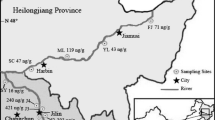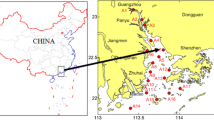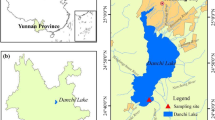Abstract
Spatial and temporal distributions of concentrations of polycyclic aromatic hydrocarbons (PAHs) in surface sediments and dated sediment core from Taihu Lake in eastern China were determined. The sum of concentrations of PAHs (sum of total 16 USEPA priority PAH (∑PAHs)) of the entire Taihu Lake ranged from 2.9 × 102 to 8.4 × 102 ng/g dry mass (dm). Concentrations of ∑PAHs in surface sediments near more urbanized regions of the lake shore were greater than those in areas more remote from the urban centers. Temporal trends in concentrations of ∑PAHs ranged from 5.1 × 102 to 1.5 × 103 ng/g dm, increasing from deeper layers to surface sediments with some fluctuations, especially in the past three decades after the inception of China’s Reform and Opening Up Policy, in which China’s economy and urbanization underwent rapid development. Forensic analysis of surface sediments indicates that PAHs originated primarily from combustion of grass/wood/coal except for the special function water area, which was most likely influenced by petroleum products of traveling vessels. Vertical profiles of relative concentrations of PAHs suggested that the contribution of lesser-molecular-weight PAHs was gradually decreasing, while due to the heavier consumption of petroleum products, the proportion of greater-molecular-weight PAHs was increasing. When assessed by use of the rather conservative, apparent effect threshold method, concentrations of ∑PAHs in sediments from most locations in Taihu Lake are predicted to pose little risk of harm to benthic invertebrates.









Similar content being viewed by others
References
Baudo R (1990) Sediments: chemistry and toxicity of in-place pollutants. CRC, Boca Raton, p 405
Baumard P, Budzinski H, Garrigues P (1998) Polycyclic aromatic hydrocarbons in sediments and mussels of the western Mediterranean Sea. Environ Toxicol Chem 17:765–776
De Luca G, Furesi A, Leardi R, Micera G, Panzanelli A, Costantina Piu P, Sanna G (2004) Polycyclic aromatic hydrocarbons assessment in the sediments of the Porto Torres Harbor (Northern Sardinia, Italy). Mar Chem 86:15–32
De Luca G, Furesi A, Micera G, Panzanelli A, Piu PC, Pilo MI, Spano N, Sanna G (2005) Nature, distribution and origin of polycyclic aromatic hydrocarbons (PAHs) in the sediments of Olbia harbor (Northern Sardinia, Italy). Mar Pollut Bull 50:1223–1232
Giesy, J. P. and R. A. Hoke. 1990. Freshwater sediment quality criteria: toxicity bioassessment. In: R. Baudo, J. Giesy and H. Muntau (eds.) Sediments: the chemistry and toxicology of in-place pollutants. Lewis Publishers, Chelsea, Michigan. pp. 265–348
Glew JR (1988) A portable extruding device for close interval sectioning of unconsolidated core samples. J Paleolimnol 1:235–239
Gogou A, Bouloubassi I, Setephanou EG (2000) Marine organic geochemistry of the Eastern Mediterranean: 1. Aliphatic and polyaromatic hydrocarbons in Cretan Sea surficial sediments. Mar Chem 68:265–282
Guo JY, Wu FC, Luo XJ, Zhang L, Liao HQ, Zhu YR, Li W, Zhao XL, Chen SJ, Mai BX (2010) Anthropogenic input of polycyclic aromatic hydrocarbons into five lakes in Western China. Environ Pollut 158:2175–2180
Guo JY, Liang Z, Liao HQ, Tang Z, Zhao XL, Wu FC (2011) Sedimentary record of polycyclic aromatic hydrocarbons in Lake Erhai, Southwest China. J Environ Sci 23:1308–1315
Guo JY, Wu FC, Zhao XL, Liao HQ, Li W, Wang J, Wang LF, Giesy JP (2013) Sedimentary record of polycyclic aromatic hydrocarbons and DDTs in Dianchi Lake, an urban lake in Southwest China. Environ Sci Pollut Res 20:5471–5480
Harrison RM, Smith D, Luhana L (1996) Source apportionment of atmospheric polycyclic aromatic hydrocarbons collected from an urban location in Birmingham, UK. Environ Sci Technol 30:825–832
Hu GC, Luo XJ, Li FC, Dai JY, Guo JY, Chen SJ, Hong C, Mai BX, Xu MQ (2010) Organochlorine compounds and polycyclic aromatic hydrocarbons in surface sediment from Baiyangdian Lake, North China: concentrations, sources profiles and potential risk. J Environ Sci (China) 22:176–183
Javier CJ, Berrojalbiz N, Wollgast J, Dachs J (2012) Polycyclic aromatic hydrocarbons (PAHs) in the Mediterranean Sea: atmospheric occurrence, deposition and decoupling with settling fluxes in the water column. Environ Pollut 166:40–47
Jiangsu Municipal statistical bureau (2013) Jiangsu statistical yearbook. China Statistical Publishing House, Jiangsu
Kannan K, Johnson-Restrepo B, Yohn SS, Giesy JP, Long DT (2005) Spatial and temporal distribution of polycyclic aromatic hydrocarbons in sediments from Michigan inland lakes. Environ Sci Technol 39:4700–4706
Laflamme R, Hites RA (1978) The global distribution of polycyclic aromatic hydrocarbons in recent sediments. Geochim Cosmochim Acta 42:289–303
Lin T, Qin Y, Zheng B, Li Y, Zhang L, Guo Z (2011) Sedimentary record of polycyclic aromatic hydrocarbons in a reservoir in Northeast China. Environ Pollut 163:256–260
Liu GQ, Zhang G, Li XD, Li J, Peng XZ, Qi SH (2005) Sedimentary record of polycyclic aromatic hydrocarbons in a sediment core from the Pearl River Estuary, South China. Mar Pollut Bull 51:912–921
Liu GQ, Zhang G, Jin Z, Li J (2009) Sedimentary record of hydrophobic organic compounds in relation to regional economic development: a study of Taihu Lake, East China. Environ Pollut 157:2994–3000
Lohmann R, Jurado E, Pilson M E Q, Dachs J (2006) Oceanic deep water formation as a sink of persistent organic pollutants. Geophysical Research Letters 33: 735–742
Long ER, Morgan L (1990) The potential for biological effects of sediment-sorbed contaminants tested in the national status and trends program. National Oceanic and Atmospheric Administration, Washington
Long ER, Macdonald DD (1992) Sediment classification methods compendium. Environmental Protection Agency Sediment Oversight Technical Committee, Washington: US
Long ER, Macdonald DD, Smith SL, Calder FD (1995) Incidence of adverse biological effects within ranges of chemical concentrations in marine and estuary sediment. Environ Manag 19:81–97
Lu M, Zeng DC, Liao Y, Tong B (2012) Distribution and characterization of organochlorine pesticides and polycyclic aromatic hydrocarbons in surface sediment from Poyang Lake, China. Sci Total Environ 2012(433):491–497
Magi E, Bianco R, Lanni C, Di CM (2002) Distribution of polycyclic aromatic hydrocarbons in the sediments of the Adriatic Sea. Environ Pollut 119:91–98
Mai BX, Fu JM, Sheng GY, Kang YH, Lin Z, Zhang G, Min YS, Zeng EY (2002) Chlorinated and polycyclic aromatic hydrocarbons in riverine and estuarine sediments from Pearl River Delta, China. Environ Pollut 117:457–474
Mai BX, Qi SH, Zeng EY, Yang QS, Fu JM, Zhang G, Sheng GY, Peng PA, Wang ZS (2003) Distribution of polycyclic aromatic hydrocarbons in the coastal region off Macao, China: assessment of input sources and transport pathways using compositional analysis. Environ Sci Technol 37:4855–4863
Marchand N, Besombes J, Chevron N, Masclet P, Aymoz G, Jaffrezo J (2004) Polycyclic aromatic hydrocarbons (PAHs) in the atmospheres of two French alpine valleys: sources and temporal patterns. Atmos Chem Phys 4:1181
McDonough CA, Khairy MA, Muir DCG, Lohmann R (2014) Significance of population centers as sources of gaseous and dissolved PAHs in the Lower Great Lakes. Environ Sci Technol 48:7789–7797
Qiao M, Wang CX, Huang SB, Wang D, Wang Z (2006) Composition, sources, and potential toxicological significance of PAHs in the surface sediments of the Meiliang Bay, Taihu Lake, China. Environ Int 32:28–33
Qin N, He W, Kong XZ, Liu WX, He QS, Yang B, Ouyang HL, Wang QM, Xu FL (2013) Atmospheric partitioning and the air-water exchange of polycyclic aromatic hydrocarbons in a large shallow Chinese lake (Lake Chaohu). Chemosphere 93:1685–1693
Qin N, He W, Kong XZ, Liu WX, He QS, Yang B, Wang QM, Xu FL, Yang C, Jiang YJ, Jorgensen SE, Xu FL, Zhao XL (2014) Distribution, partitioning and sources of polycyclic aromatic hydrocarbons in the water-SPM-sediment system of Lake Chaohu, China. Sci Total Environ 496:414–423
Ravindra K, Sokhi R, Van Grieken R (2008) Atmospheric polycyclic aromatic hydrocarbons: source attribution, emission factors and regulation. Atmos Environ 42:2895–2921
Shi Z, Tao S, Pan B, Liu WX, Shen WR (2007) Partitioning and source diagnostics of polycyclic aromatic hydrocarbons in rivers in Tianjin, China. Environ Pollut 146:492–500
Soclo HH, Garrigues PH, Ewald M (2000) Origin of polycyclic aromatic hydrocarbons (PAHs) in coastal marine sediments: case studies in Cotonou (Benin) and Aquitaine (France) area. Mar Pollut Bull 40:387–396
Tang Z, Liao HQ, Zhang L, Guo JY, Wu FC, Guo F, Zhou BH (2011) Distribution, source and risk assessment of polycyclic aromatic hydrocarbons in river sediment of Cheng-Yu economic zone. Environ Sci 32:2639–2644
Tsapakis M, Stephanou EG (2005) Occurrence of gaseous and particulate polycyclic aromatic hydrocarbons in the urban atmosphere: study of sources and ambient temperature effect on the gas/particle concentration and distribution. Environ Pollut 133:147–156
Viñas L, Angeles Franco M, Antonio Soriano J, José González J, Pon J, Albaigés J (2010) Sources and distribution of polycyclic aromatic hydrocarbons in sediments from the Spanish northern continental shelf. Assessment of spatial and temporal trends. Environ Pollut 158:1551–1560
Wang W, Massey Simonich SL, Xue M, Zhao JY, Zhang N, Wang R, Cao J, Tao S (2010) Concentrations, sources and spatial distribution of polycyclic aromatic hydrocarbons in soils from Beijing, Tianjin and surrounding areas, North China. Environ Pollut 158:1245–1251
Wenchuan Q, Dickman M, Chengxin F (2002) Distribution, sources and potential toxicological significance of polycyclic aromatic hydrocarbons (PAHs) in Taihu Lake sediments, China. Hydrobiologia 485(1–3):163–171
Westerholm R, Li H (1994) A multivariate statistical analysis of fuel-related polycyclic aromatic hydrocarbon emissions from heavy-duty diesel vehicles. Environ Sci Technol 28:965–972
Wu FC, Wan GJ, Cai YR (1996) Biogeochemical processes at the sediment-water interface. Adv Earth Sci 11:191–197
Wuxi Municipal Statistical Bureau (2013) 2013 Statistical yearbook of Wuxi. China Statistical Publishing House, Wuxi
Yan W, Chi JS, Wang ZY, Huang WX, Zhang G (2009) Spatial and temporal distribution of polycyclic aromatic hydrocarbons(PAHs) in sediments from Daya Bay, South China. Environ Pollut 157:1823–1830
Yunker MB, Macdonald RW, Vingarzan R (2002) PAHs in the Fraser River basin: a critical appraisal of PAH ratios as indicators of PAH source and composition. Org Geochem 33:489–515
Zeng EY, Venkatesan M (1999) Dispersion of sediment DDTs in the coastal ocean off southern California. Sci Total Environ 229:195–208
Zhao SM, Wang B, Wang DW (2014) Environmental behavior of PAHs in Dianchi Lake distributions, sources and risk assessment of polycyclic aromatic hydrocarbons in surface sediments from Dianchi Lake, China. Int J Environ Res 8(2):317–328
Acknowledgments
This study was financed by the Natural Science Foundation of China (41222026, 21007063, 41130743). Prof. Giesy was supported by the program of 2012 “High Level Foreign Experts” (#GDW20123200120) funded by the State Administration of Foreign Experts Affairs, People’s Republic of China, to Nanjing University and the Einstein Professor Program of the Chinese Academy of Sciences. He was also supported by the Canada Research Chair program, a Visiting Distinguished Professorship in the Department of Biology and Chemistry and State Key Laboratory in Marine Pollution, City University of Hong Kong.
Author information
Authors and Affiliations
Corresponding authors
Additional information
Responsible editor: Philippe Garrigues
Rights and permissions
About this article
Cite this article
Tang, Z., Guo, J., Liao, H. et al. Spatial and temporal distribution and sources of polycyclic aromatic hydrocarbons in sediments of Taihu Lake, eastern China. Environ Sci Pollut Res 22, 5350–5358 (2015). https://doi.org/10.1007/s11356-014-3746-2
Received:
Accepted:
Published:
Issue Date:
DOI: https://doi.org/10.1007/s11356-014-3746-2




